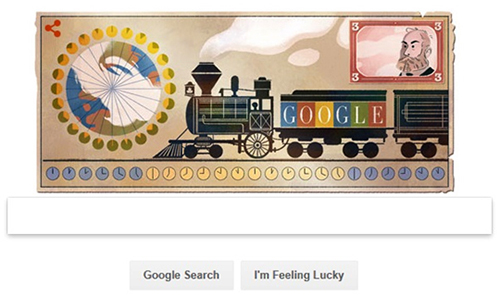Sir Sandford Fleming: Public Works employee and the “father of standard time”
Like most Canadians, you may still be adjusting to the effects of daylight saving time. But did you know that time zones are a Canadian invention? They were the idea of Sir Sandford Fleming, an engineer with the Department of Public Works, which is now part of Public Services and Procurement Canada.
Shaping Canada with stamps and steel
Sir Sandford Fleming was born in 1827 in Scotland. Fleming immigrated to Canada in 1845 to work as a surveyor. In 1849, he helped create the Royal Canadian Institute, a scientific society for surveyors, civil engineers and architects. The society later expanded to include many other sciences.
Two years later, Fleming designed the first Canadian postage stamp. The Three-Penny Beaver stamp included the image of a beaver, helping turn the hard-working rodent into a Canadian symbol.
In 1857, as chief engineer of the Northern Railway of Canada, Fleming began looking at new ways to build railways. Instead of using timber, he built railway bridges out of steel. His pioneering approach was instrumental in building the Intercolonial Railway beginning in 1867, the year of Confederation.
Fleming surveyed and mapped much of our country. Most notably, he engineered much of the Canadian Pacific Railway from Ottawa to the Pacific. As the rail lines extended west, Public Works built telegraph lines and operated telegraph offices in the towns and villages that developed along the route.
A man ahead of his time
Despite these achievements, it was a “timely” invention that brought Sir Sandford Fleming worldwide fame. From working on the railroads (and missing a train in Ireland), Fleming devised a standardized time system that relied on hour-wide time zones.
Before standard time, every community based its time on the location of the sun. With railway lines criss-crossing the country, railway station masters had a harder and harder time dealing with train schedules. Fleming’s system divided the world into time zones, each exactly one hour apart. This made it possible to schedule the times when tracks were used and to avoid head-on collisions. After Fleming promoted what he called “cosmic time,” standard time went into effect on January 1, 1885. By 1929, all major countries in the world were using time zones.
For his many accomplishments, Sir Sandford Fleming was knighted in 1897 on the occasion of Queen Victoria's Diamond Jubilee. The “father of standard time” died in Halifax on July 22, 1915, leaving behind an incredible legacy. As the Canadian Heritage Minute video acknowledges, Fleming helped build not only Canadian railways, but Canada itself. His ingenuity and steadfast dedication made him a famous surveyor, designer, engineer and inventor, and he is a credit to our department and our country.
Learn more about Sir Sandford Fleming
Consult a timeline of events in Sir Sandford Fleming’s life. Discover some other interesting facts that show Fleming’s importance across Canada and around the world.
Infographic: Sir Sandford Fleming, the “father of standard time”
Learn about the milestones in the remarkable life of Sir Sandford Fleming.

Description for Infographic: Sir Sandford Fleming: the “father of standard time”
- 1827: Born in Kirkcaldy, Scotland
- 1845: Immigrated to Canada
- 1849: Co-founded the Royal Canadian Institute
- 1851: Designed Canada’s first stamp
- 1857: Became chief engineer of Northern Railway
- 1867: Named chief engineer of Intercolonial Railway
- 1885: Standard time went into effect
- 1897: Knighted during Queen Victoria’s Diamond Jubilee
- 1902: Underwater cable from Vancouver to New Zealand and Australia completed
- 1915: Died in Halifax, Nova Scotia
Google Doodle honouring Sir Sandford Fleming
On the 190th anniversary of his birth, Sir Sandford Fleming was honoured with a Google Doodle. Google added this temporary logo to its web page to illustrate some of Fleming’s achievements, such as his:
- development of time zones
- pioneering approach to engineering railways
- creation of a standardized time system to help trains run efficiently and avoid collisions
- design of the first Canadian stamp

A town in Saskatchewan named after Sir Sandford Fleming
So profound were Sir Sandford Fleming’s achievements, there is even a town in Saskatchewan named after him.


A park in Halifax named after Sir Sandford Fleming
In 1908, Sir Sandford Fleming donated his 95-acre property to the city of Halifax for use as a public park, which was named Fleming Park.
Now that you’ve read the story, test your knowledge by taking our quiz.
- Date modified: